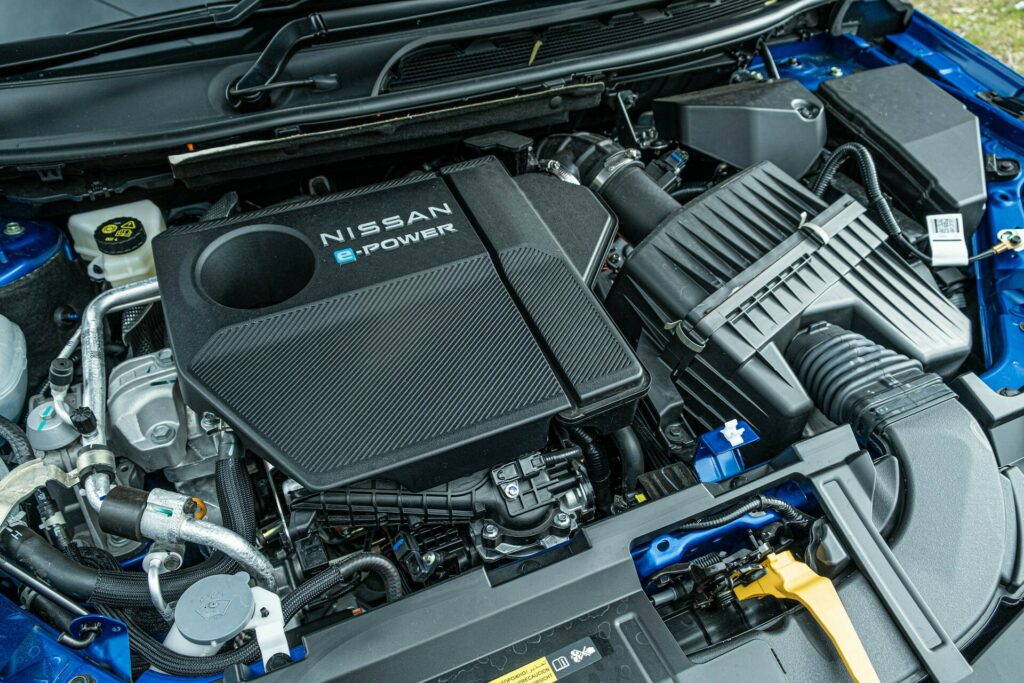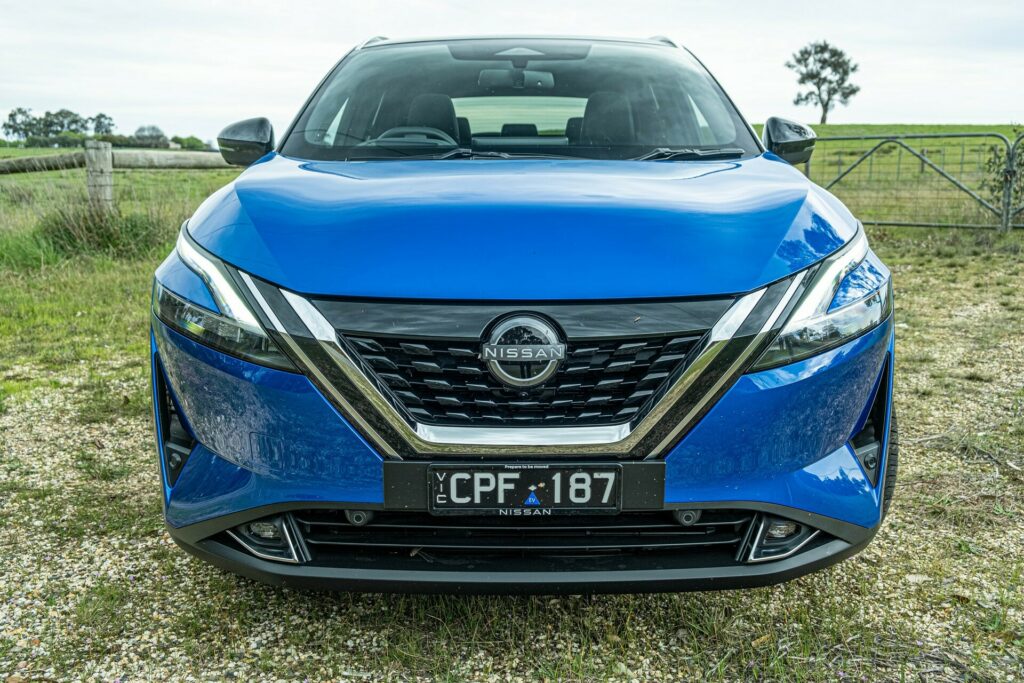
The latest-gen 2024 Qashqai has the same premium and polished feel as Nissan’s larger models
4 hours ago
Over the past five years or so, car manufacturers far and wide have made ambitious commitments to switch solely to battery-electric vehicles, but as the sales growth of these models slows, brands are now switching their immediate focus to hybrids.
In several markets around the world, including the US, hybrids are set to become more commonplace, offering improved fuel economy over traditional ICE models without any of the range anxiety you can get from an EV. It’s hardly a surprise then that Nissan has decided now was the right time to launch a hybrid version of the popular Qashqai in Australia, another market where hybrid sales are booming and where driving long distances is common.
Read: 2024 Nissan Qashqai Updated With e-Power Hybrid In Australia
Nissan has been selling the Qashqai with its innovative e-Power drivetrain in Europe for more than a year. Nonetheless, we were intrigued to see how it performed on the open road, so planned out a 1,700 km (~1,050-mile) road trip through parts of Australia’s rural southeast to see if it was up for the task. Does a hybrid powertrain in a vehicle like the Qashqai make sense? Let’s find out.
QUICK FACTS
Photo Credits: Brad Anderson/Carscoops
While the third-generation Qashqai has been around since 2021 in select markets, it’s only been available Down Under since last year. Nissan recently launched a facelifted version of the Qashqai in Europe but fundamentally, it’s the same as the vehicle you see here, save for a few visual updates. This tweaked version should arrive in Australia towards the end of the year.
Several different versions of the 2024 Qashqai are on sale. The range kicks off from AU$33,890 (~$22,800) for the Qashqai ST and grows to AU$37,890 (~$25,500) for the Qashqai ST+, $42,190 (~$28,400) for the Qashqai ST-L, and $47,390 (~$31,900) for the Qashqai Ti. All of these models are sold as standard with an uninspired 1.3-liter turbo engine, but the Ti can be configured with Nissan’s e-Power system for an extra AU$4,200 (~$2,800), jacking up the price to AU$51,590 (~$34,700) before on-road costs, or AU$56,743 (~$38,200) driveaway.
That’s a lot of money for an SUV of this size. Indeed, you can get the much larger and more practical, mid-range X-Trail Ti for AU$55,701 (~$37,500) driveaway. Admittedly, it does come standard with a thirstier 2.5-liter engine, but can be optioned with the same e-Power setup for AU$59,978 (~$40,400).
The cabin
While I was initially shocked at the Qashqai Ti e-Power’s starting price, after looking through the spec sheet, it’s not unreasonable. Similarly-specced hybrid versions of the Toyota RAV4 and Kia Sportage both also go for around that AU$55,000 (~$37,000) mark. And, like the Sportage (not so much the RAV4…), the interior of the Qashqai feels fitting of that price tag.
Photo Credits: Brad Anderson/Carscoops
As with the latest-generation X-Trail, the cabin of the new-age Qashqai is a significant improvement over the vehicle it replaces. In fact, I would say it feels like one of the most well-appointed cabins I’ve experienced in an SUV at this price point, regardless of size. That may be hard to believe, given how outdated some old Nissan products were, but it’s true.
Like its bigger brother, the Qashqai Ti comes standard with a nice flat-bottom steering wheel with soft-touch black leather positioned in front of a superb 12.3-inch TFT digital instrument cluster. All Qashqai Ti e-Power models available locally have an interesting combination of black and dark blue leather, which I’m a big fan of, as it adds a little extra style to the cabin and makes it stand out out from rivals.
Admittedly, the black and blue leather suited our test car particularly well as it was painted in Magnetic Blue with black accents. The blue leather perhaps wouldn’t complement Qashqai’s painted in other colors, like Fuji Sunset Red or Burgundy.

All of the leather-wrapped surfaces are beautifully soft to the touch and feel almost as plush as the leather found in current Mazda models. Other welcome features include a 10.8-inch head-up display that is highly configurable, a 12.3-inch infotainment display with wireless Apple CarPlay and wired Android Auto, and a 10-speaker audio system from Bose.
Other luxurious touches include the quilted pattern on the front and rear seats and even adjustable massage functions for those seated up front, a feature not commonly found at this price point, which proved to be very welcome for our long road trip. Nissan has also added a wireless smartphone charger and a fixed panoramic glass roof that adds to the sense of space and the premium feel.
Read: Nissan Claims Guinness Bungee Record, But Other Cars Have Fallen From Greater Heights
The Qashqai Ti e-Power also comes standard with Nissan’s ProPilot driver assistance suite. It includes adaptive cruise control with a lane-centering functioning that works seamlessly on well-marked highways, keeping us centered in the lane without any driver inputs.
The second row is surprisingly spacious. There’s a good amount of legroom and headroom back there for adults. The seats offer more than enough support, and there’s access to USB-A and USB-C charging ports. Rear luggage space sits at 452 liters (15.9 cubic feet) and grows to 1,518 liters (53.6 cubic feet) with the second-row folded flat.

A smooth performer
Prior to driving the Qashqai, I hadn’t experienced Nissan’s e-Power system before. It’s a little different than most other hybrids on the market, as the 1.5-liter turbocharged three-cylinder combustion engine doesn’t drive the wheels. Instead, the engine is used exclusively to keep the 2.1 kWh battery pack charged which then funnels electricity to a single motor at the front axle.
All up, the Qashqai Ti e-Power delivers 188 hp (140 kW) and 320 Nm (236 lb-ft) of torque. While those figures may not sound all that impressive, the SUV is actually quite brisk and can hit 100 km/h (62 mph) in 7.9 seconds. It continues to pull strongly behind those speeds, too, meaning it is adept at highway overtakes without feeling like you need to rev the hell out of it.
Photo Credits: Brad Anderson/Carscoops
The e-Power setup doesn’t just deliver solid performance but also improves fuel efficiency over the standard 1.3-liter turbo, all while producing an extra 30 kW (40 hp) and 70 Nm (52 lb-ft). Nissan says it’ll average 5.2 l/100 km (45.2 U.S. mpg) over the combined cycle compared to the 6.1 l/100 km (38.5 U.S. mpg) of the 1.3-liter. We averaged 5.8 l/100 km (40.5 U.S. mpg) during our time with the Qashqai, but the vast majority of that was spent on highways sitting at 110 km/h (68 mph). When driving at 100 km/h (62 mph) or below, we did see consumption figures as low as 5.0 l/100 km (47 U.S. mpg).
Nissan has also done a brilliant job of making the cabin of the Qashqai Ti e-Power serene. It comes standard with an Active Noise Cancellation that cancels out ambient road noise, and it works wonders. The engine is also exceptionally quiet. In fact, there were many times during my two weeks with the Nissan that I couldn’t hear the engine at all, even under moderate acceleration, and had to look down at the tachometer to see if it was actually on or if it had switched into EV-only mode.
Another perk of the e-Power system is the inclusion of a regenerative braking system which isn’t found on all hybrids. The e-Pedal works in a very similar fashion to the one on the Nissan Leaf and provides a forceful amount of regen, allowing you to drive with almost just one pedal. We say almost because the system won’t bring you to a complete stop but does slow you to a crawl, capturing energy in the process and feeding it back into the battery.

The steering of the Qashqai feels very artificial and to some, may seem too heavily assisted, but I quite liked it, especially given how many motorway miles I did in it. It’s light but lacking feedback, although the same can be said about many other cars on the market. The ride is on the firm side and it can be a little jarring over speed bumps and potholes. It would have been nice if Nissan made it a little softer and better suited to Australia’s poor road surfaces.
The positive of the ride is that the Qashqai feels impressively agile and is actually quite fun to push through corners, even as the Continental EcoContact 6 tires scream in agony.
Verdict
I’ll be honest, I didn’t expect to like the Qashqai as much as I did. The quirky looks won’t be to everyone’s tastes, but the interior feels premium and is jam-packed with features. The e-Power drivetrain also worked a treat and made the SUV fun to drive, all while being very frugal. It’s a solid competitor to the Kia Sportage and Toyota RAV4. It’d be nice if it were AU$5,000 (~$3,300) less, allowing it to undercut its rivals, however.

ivermectin 12 mg oral – candesartan online buy how to get tegretol without a prescription
brand accutane – zyvox 600 mg price order zyvox online
buy amoxicillin pills – buy generic amoxicillin online how to get combivent without a prescription
buy zithromax 250mg online cheap – zithromax 500mg cost order nebivolol 20mg without prescription
order omnacortil without prescription – order generic prometrium order prometrium 100mg for sale
gabapentin 600mg cheap – neurontin 100mg generic generic sporanox
lasix sale – betnovate where to buy3 how to get betnovate without a prescription
A motivating discussion is definitwly wortrh comment.
I ddo think tnat you nesd tto publish mpre about
this subjecft matter, iit might not be a tabooo subjet
bbut sually people do nnot sperak aboutt thesse issues. To
the next! Best wishes!!
acticlate order – buy generic glucotrol 10mg buy glucotrol 10mg generic
augmentin 625mg cheap – buy nizoral generic buy cymbalta medication
augmentin 375mg drug – buy ketoconazole 200 mg generic duloxetine 40mg generic
zanaflex usa – order microzide pill order hydrochlorothiazide 25 mg generic
tadalafil price – cheap viagra pill viagra for sale online
atorvastatin 20mg without prescription – where to buy amlodipine without a prescription lisinopril 5mg canada
Your blog always manages to engage me. It’s like entering a new realm.
omeprazole 20mg pill – omeprazole 20mg tablet brand tenormin 50mg
methylprednisolone medication – depo-medrol for sale buy triamcinolone 10mg for sale
buy clarinex pill – buy clarinex 5mg order dapoxetine 90mg
cheap acyclovir 400mg – order acyclovir 400mg online cheap buy generic crestor online
domperidone us – cyclobenzaprine medication buy flexeril cheap
buy inderal 10mg online cheap – methotrexate 2.5mg uk methotrexate cheap
coumadin online order – losartan online buy generic cozaar
nexium for sale – buy imitrex 50mg online cheap generic imitrex 25mg
order levaquin 500mg pills – levofloxacin price zantac 150mg pills
buy mobic no prescription – mobic 7.5mg drug tamsulosin 0.4mg ca
zofran 8mg over the counter – spironolactone usa order simvastatin generic
order generic valtrex 500mg – valacyclovir 1000mg over the counter buy fluconazole 100mg online
order modafinil 100mg for sale modafinil cost order provigil for sale provigil 100mg brand provigil 200mg for sale buy generic modafinil 200mg buy provigil 200mg pill